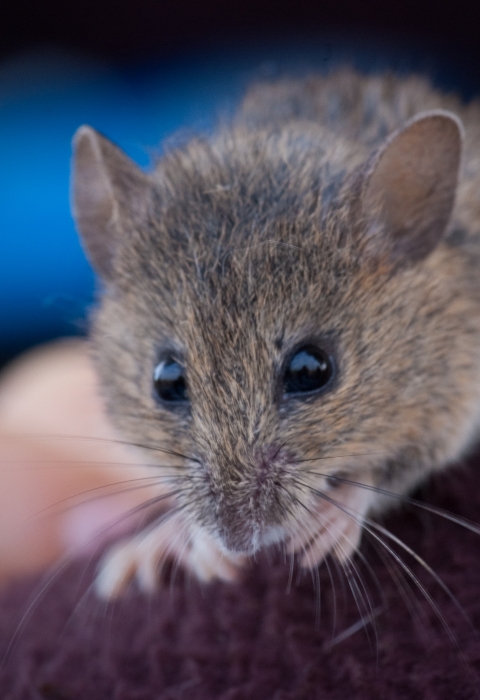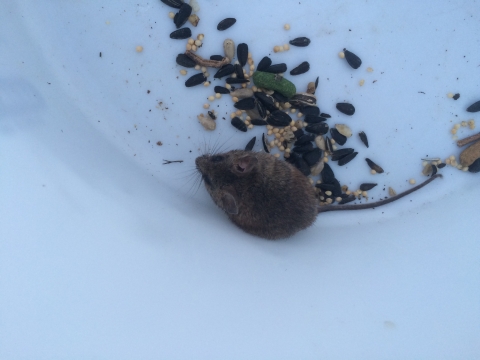The week of July 20 proved to be a huge milestone for two endangered species and a restoration area known as Pond A21, located on the Don Edwards San Francisco Bay National Wildlife Refuge near San Jose, CA.
Salt marshes are found in tidal areas near the coast, where freshwater mixes with saltwater.
Learn more about salt marsh harvest mice found on A21 during the recent survey.
Pond A21, one of the Island Ponds, is a key component of an impressive effort that began in 2003, when the U.S. Fish and Wildlife Service and California Department of Fish and Wildlife acquired approximately 15,000 acres of former commercial salt ponds from the Cargill Salt Company with the goal of restoring the area for a variety of native species – including endangered salt marsh harvest mouse and California clapper rail, recently renamed Ridgway’s rail. Another significant marker occurred in 2006, when A21 was breached as part of the Initial Stewardship Plan of the South Bay Salt Pond Restoration Project.
Since the 2006 breach, the Tidal Marsh Recovery Plan was published, and each year the Service instituted a survey plan while waiting for vegetation to develop to be able to support those species. Eventually, those newly restored marshes will be populated to connect current areas that have Ridgway’s rails and salt marsh harvest mice , thereby increasing marsh acreage and habitat connectivity.
Efforts started to pay off last year in a big way, when the first Ridgway’s rail was spotted in A21 in July 2014 by staff with the Invasive Spartina Project. Then, during the first surveys for salt marsh harvest mice on July 22 this year, biologists heard the call of the first breeding pair of Ridgway’s rails.
After setting more than 100 live-traps over three nights, biologists caught four salt marsh harvest mice during those first surveys. Biologists caught a total of 63 unique small mammals at A21, including salt marsh harvest mice, Western harvest mice, deer mice and house mice.
“Everyone was extremely excited; it was well above our expectations for how quickly this would happen, being less than 10 years since the area was breached,” said Service wildlife biologist Rachel Tertes, who heads up the survey efforts for the refuge. “This shows that we’re accomplishing what we’re trying to accomplish, that if we provide habitat the species will come.”
That both Ridgway’s rail and salt marsh harvest mice are already moving into the newly created habitat took everyone by surprise, said Tertes, who started with Service as an intern on the Refuge in 1999. She estimates there are at least the two Ridgway’s rails on A21, and possibly more. The Service has done breeding season surveys since 2012, but it wasn’t until last summer that detection occurred, even though proper habitat and vegetation were in place.
Tertes said there weren’t any mammals on A21 before the breach, only waterfowl and shorebirds.
“We were also pleasantly surprised to find deer mice during the recent surveys,” Tertes said. “Though deer mice aren’t rare, it was exciting for us to find a new species we generally don’t catch during our small mammal trapping efforts.” She said UC Davis researchers also found longfin smelt – listed as threatened by the State of California and as candidate for protection by the Service – as well as Mysid shrimp at the site.
“It’s been pretty impressive to see all of the parties who have come together on this restoration effort, from Fortune 500 companies to environmental groups,” said Colin Grant, the endangered species listing and recovery biologist in San Francisco Bay-Delta Fish and Wildlife Office. Grant was part of the survey crew on July 22 when the Ridgway’s rail breeding pair was detected.
The recent successful surveys came at the end of Phase 1 of the South Bay Salt Pond Restoration Project, the largest tidal restoration effort on the West Coast. Phase 2 planning for Alviso and Ravenswood ponds has already begun – a public meeting and walking tours were held August 4. Phase 2 restoration and public access alternatives will include options such as enhancing the ponds for pond birds or shore birds, adding bird islands and habitat transition areas, building public trails, improving levees, designing the ponds to store stormwater, potential incorporating the City of Redwood City’s Bayfront Canal and Atherton Channel Projects.
“In 10 years, the area will be a fully tidal marsh that has well-structured channels and the appropriate vegetation to sustain endangered species and other plants and animals,” Tertes said.





